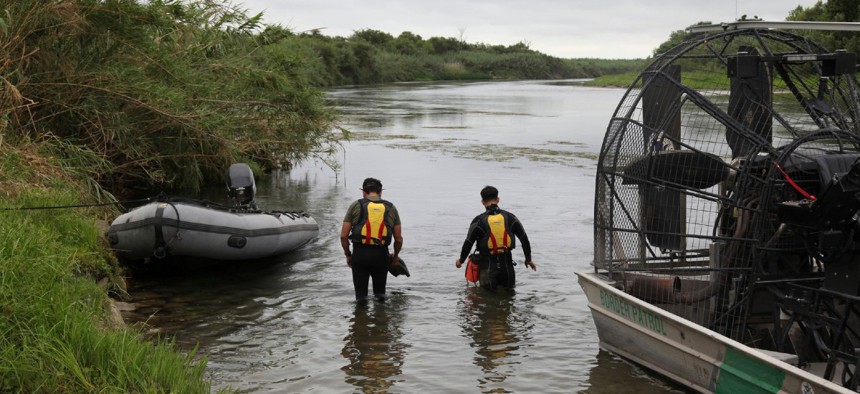Border Patrol Needs Automated Sensors to Cover Watery Blindspots

This July 2, 2019 photo provided by the U.S. Customs and Border Protection Agency shows a U.S. Border Patrol Del Rio Sector Dive Team searching for a 2-year-old Haitian girl in Rio Grande River in Del Rio, Texas. Customs and Border Protection Agency via AP
Homeland Security is looking for a technical solution to give border agents situational awareness about illegal watercraft and the potential risks of interdiction.
Customs and Border Protection has been using technology to beef up its ability to detect people and objects moving illegally across the border. But the network of sensors still has a major blind spot: waterways.
CBP, through a partnership with Homeland Security Department’s Science and Technology Directorate, is looking for innovative technologies—or combinations of technologies—to provide situational awareness at all bodies of water adjacent to the border, including smaller waterways like streams, rivers and lakes.
Border Patrol “agents are often tasked with performing their border security mission with limited to no surveillance capabilities and limited situational awareness in and around such areas,” according to a request for information posted Tuesday to beta.SAM.gov. “Operational environments often have elevation differences like ridges along banks or deviated shorelines and provide naturally occurring concealment opportunities such as coves and isles and overgrown vegetation. These conditions limit the effectiveness of existing short-, mid-, and long-range surveillance technologies.”
The perfect solution would give border agents real-time information about watercraft—or items of interest—“transiting remote, difficult-to-monitor waterways,” including any people that might be aboard and coming ashore between legal border crossings.
The tools should be fully automated and provide “detection, identification, classification, tracking and alerting” capabilities to help border agents make decisions about when to intercede and the likely level of risk associated. The tech should also be small enough for an agent to carry on their person and easy enough for anyone to use.
The RFI offers a list of required features to give vendors an idea of what the government is asking for, including:
- Small, agent portable.
- Agent deployable/re-deployable.
- Concealable.
- Remote unattended sensors for real time.
- Automated.
- Year-round detection.
- Alerting of suspicious activities day and night and in varying weather conditions.
- Incorporate low-power techniques that maximize battery replacement times.
- Include integrated communications to provide reliable methods of backhauling data from remote locations.
- Provide high probabilities of detection and alerting, low false/nuisance alarm rates.
- Affordable.
The proposed capabilities must also meet a majority of 10 key success criteria, including: affordability, deployability, autonomy, connectivity, system performance, environmental, simplicity, security, scalability and have an open architecture that enables data sharing. The RFI gives some details on each of the criteria.
Homeland Security is specifically looking for technologies that are beyond the initial development stage and “have already undergone some development and prototyping to ensure that the technologies meet the key success criteria.”
White papers in response to the RFI are due by 3 p.m. Feb. 25.
NEXT STORY: DARPA Wants Research on Regrowing Human Organs






